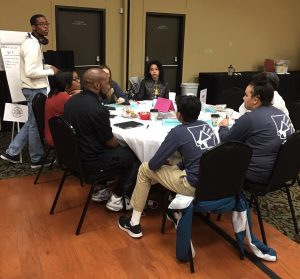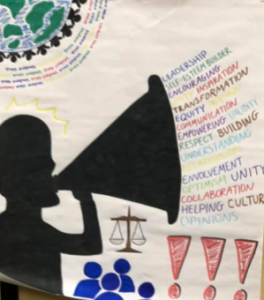TL;DR:
- Invite students to the table when making decisions about their educational journey because it is their table.
- Making student voice a priority is essential for embedding it into the learning culture.
- Relationships are the key to creating collaborative learning cultures.
My boss recently called me in and informed me that I had been working so hard and that I deserved a long vacation. Can you imagine the excitement on my face as so many exciting destinations began to flood my mind?! I could relax on the beach or maybe spend my time touring a foreign country. The opportunities were endless.
As those exciting possibilities popped in and out of my mind, he interrupted my thoughts. Yes, I was going on a journey, but he informed me that he would decide where I went on my vacation, how long I would be there, my mode of travel, and what I would do on this journey. As you can imagine, my balloon of excitement burst on the spot. To me, it seemed as he was “doing vacation to me.”
Students don’t belong at the “kiddie” table.
Obviously, this story is fictional, but this scenario seems unfair, right? As unfair as it seems, this is what we often do to students in our schools. The students are on an “educational journey,” but often, the adults make all of the decisions about their journey. We teach our students until it’s exam season and then we expect them to succeed in the grades that we set for them. Often, students resort to exam prep online to review exam papers, such as the az 104 exam, to calm their nerves. “You will learn this in this amount of time, and this is how you will be assessed, and although you all are diverse, we are going to provide a uniform process for each of you.” Wouldn’t it make sense to invite students to the table when making decisions about their educational journey, because it is actually their table?
Wouldn't it make sense to invite students to the table when making decisions about their educational journey, because it is actually their table? Share on XProfessional development about student voice must occur for teachers and students to institutionalize the concept.

Over the last month, I have had the amazing opportunity to facilitate the Arkansas Leadership Academy Student Voice Institute. Teams comprising of students, teachers, and principals attend this institute for the sole purpose of working collaboratively to develop a plan to create a learning culture where all students are successful.
Did you catch the word “collaboratively”? To accomplish this goal, students must have a voice in the process. Too many of our schools reflect a culture where the adults and the students seem to be on opposite sides pushing against each other, but we must create learning cultures where collaboration is the norm.
Schools were created for students, not adults.
When schools were created many years ago, they were not created to attend to the needs of the adults. Schools were created for students and for the purpose of preparing them to become successful adults. Of course, we need adults to guide this process, but over time, it seems that we have moved the needle to address the needs of the adults instead of the students. When we remove student input and voice, we are saying that your input is not valuable.
We must operationalize the term “student voice.”
One of the greatest barriers to the implementation of student voice is the fact that there are so many misconceptions about the initiative. Giving students a voice does not mean that the students are now making all the decisions or that we have turned over the school to the students. Nor does it mean that the adults and students are now on an equal playing field. Teachers are still teachers, and students are still students, but we now involve the students’ voices when discussing their educational journey.
Student voice is not solely an “affective” initiative.
Giving students a voice and validating their voice goes much deeper than merely creating positive vibes throughout the school. Students who are giving a voice in their educational journey are seven times more likely to be academically motivated. Academic motivation leads to deeper learning and improved assessment scores. Yes, school leaders, I am talking to you!
Student voice goes much deeper than academic improvement.
Although implementing student voice increases academic motivation, there are some other outcomes that I feel are even more important. These outcomes go much deeper. When students have a voice in their educational journey, they are more likely to have stronger self-worth and feel as if they have a purpose. So many students struggle with mental health issues, feeling that they are not worthy, or don’t have a purpose. Building those relationships with students where we are validating their voice sends the message that students are important and that they have a purpose at school.
Relationships are the key to creating collaborative learning cultures.
The foundation of creating a collaborative learning culture where students’ voices are heard and validated begins with positive relationships between teachers and students. Without this mutual respect, student voices will rarely be heard. Over the last 15 years, I have interviewed thousands of students through surveys, focus groups, and individually. I always ask the students, “What can the adults do to help you learn and be successful?” Overwhelmingly, the most common response is, “I need them to care about me as a person and have a relationship with me.” If we chose this profession for the right reason, this is not difficult.
Students blossom as leaders when given a chance to offer their voice.
How do we expect our young people to adequately be prepared to take their place in a democratic society if we stifle their voice for the first twelve years of their educational journey? Implementing student voice not only provides an opportunity to have a voice but also provides an opportunity to impart how to properly and professionally provide their input. This process grows leadership skills in our young people.
Making student voice a priority is essential for embedding it into the learning culture.
Student voice is not just “something we do.” It’s the fabric that is interwoven throughout every aspect of our school. It is much deeper than solely allowing students to have a voice in their educational journey. If we stop there, we are limiting the potential of impact. Student voice is transforming what school looks like to better meet the educational needs of every student. To meet this objective, student voice must become a priority in all aspects of the school.
Leaders, if you are not giving teachers a voice, don’t expect support for student voice.
Many teachers with whom I have visited share with me that they do not have a voice in school decisions. To embed student voice in our collaborative culture, teachers must feel that their voice is validated as well. A collaborative learning culture means that all voices are heard, respected, and validated. Collaboration without all voices seems to be an oxymoron.
Student voice is a concept that benefits both students and teachers.
The concept of student voice allows students and teachers to work collaboratively to improve student learning. Although we often focus much of the conversation on the positive effects for students, the concept yields positive effects for teachers as well.
We must create collaborative learning cultures and structures before we can expect positive outcomes.
With a strong focus on standards, state assessments, and accountability, we often forget that positive outcomes from these components begin with laying the foundation for learning. If we take the time to create structures where students and teachers are collaboratively creating learning cultures where all students can be successful, then we will see an increase in student outcomes and school accountability. The research is there. Student voice increases the likelihood of student learning.
What would happen if all states created a department at the state level solely focused on providing support for creating such cultures? It is my opinion that this is the missing piece of the puzzle.
[scroll down to keep reading]Don’t let this concept of student voice scare the “how” out of you! Just begin conversations with students.
The “what” and the “why” of student voice are relatively simple, but sometimes we fear the “how.” I often hear from fellow educators, “We understand the concept of student voice, and we know the research correlating it with student achievement, but how do we get started?”
We start by creating structures for students and teachers to have conversations. Conversations can be individualized with students about their learning style and their strengths and talents or the conversations can be holistic about strategies to improve the school culture. Just start talking. Results will bloom, and many of those results will be unexpected and so rewarding.
If we know better, it is time to do better.
Recently, a young lady approached me during a break at one of our sessions. This is what she shared with me with tears flowing down her face:
“I’m beginning my junior year of high school, and this is the first time anyone has ever asked me my opinion about my learning. I just always did what I was told. I knew that I could learn so much better in different ways. But nobody ever asked my thoughts. I didn’t realize I could have had a voice. I am doing pretty well in school, but I struggle often. Just think where I might be today academically if someone had asked me years ago how I learn best.”
No longer can we allow such students to slip through the cracks by “doing school to them.” Bring them to the table…and remember, it is their table.
About Blaine Alexander
Dr. Alexander is currently serving his eleventh year as a Leadership Performance Coach with the Arkansas Leadership Academy through the University of Arkansas. Prior to his current experience in leadership development, Dr. Alexander served as a school administrator for 17 years. His research focuses on developing collaborative cultures founded on trust and respect and immersed in student and adult learning. Dr. Alexander’s dissertation explores the factors necessary for student voice to be institutionalized and taken to scale in a school district. Each year, he facilitates learning for students and teachers in the Arkansas Leadership Academy’s Student Voice Institute.
Education:
B.A. Harding University, Searcy, Arkansas
M.Ed. Harding University, Searcy, Arkansas
Ed.D. University of Arkansas, Fayetteville, Arkansas
Dissertation: Student Voice Initiative: Exploring Implementation Strategies




